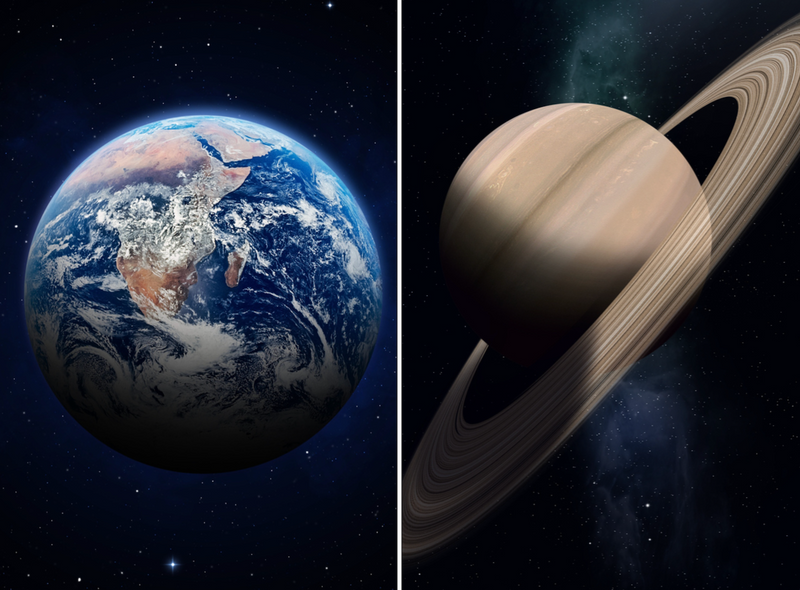Earth May Have Once Had Rings Like Saturn, and This Discovery Could Rewrite Our Planet’s Past
When we think of Saturn, its stunning rings are usually the first thing that comes to mind. But what if Earth once had a similar ring system? According to new research, that might not be as far-fetched as it sounds.
A recent study suggests that Earth may have been encircled by a ring of debris around 466 million years ago, and the implications could dramatically reshape how we understand both our planet’s climate history and its relationship with space.
The theory comes from an analysis of 21 ancient asteroid impact craters, all dating back to what's known as the “Ordovician impact spike” — a period marked by a sudden increase in meteorite activity. These craters were found clustered near Earth’s equator, which immediately raised some red flags for researchers.
This caught the scientists' attention for two major reasons. First, during this time period, over 70 percent of Earth's continental crust was located outside of the equatorial region. Second, asteroid impacts are typically random.
On the Moon and Mars, for example, craters are scattered across all latitudes. So why would Earth’s craters from this era all be found in one narrow band?
For a long time, scientists assumed that a single massive asteroid was responsible for the cluster. But the new study offers a very different explanation — one that’s far more cosmic in scale.
Researchers now believe that a large asteroid may have broken apart due to tidal forces, forming a debris ring around the planet. Over time, that ring may have slowly disintegrated, with fragments gradually falling to Earth and causing a spike in meteorite impacts.
“Over millions of years, material from this ring gradually fell to Earth, creating the spike in meteorite impacts observed in the geological record,” explained Andy Tomkins, the study’s lead author from Monash University in Australia.
“We also see that layers in sedimentary rocks from this period contain extraordinary amounts of meteorite debris.”
In other words, this wasn’t a one-time cosmic event. It may have been a sustained bombardment, fueled by a decaying ring of asteroid material that once orbited our planet, much like the rings we now associate with Saturn.
But this theory doesn't just help explain why those craters are clustered near the equator. It could also offer insights into a much broader and more mysterious chapter in Earth’s history: the Hirnantian Icehouse.
A recent study suggests that Earth may have been encircled by a ring of debris around 466 million years ago

The ring, according to the researchers, could have cast a large shadow over certain parts of Earth, potentially blocking sunlight and triggering climate changes. The idea is that this shading effect may have contributed to one of the most dramatic cooling events in the past 500 million years.
This period, from around 463 to 444 million years ago, was geologically strange. Temperatures plummeted during a time when atmospheric levels of carbon dioxide, a planet-warming gas, were unusually high. Scientists have long puzzled over what could have caused such a contradiction, and the idea of a shadow-casting debris ring adds a new possibility to the mix.
Researchers also examined the land masses that existed during the Ordovician period, focusing on areas like Western Australia, Africa, the North American Craton, and parts of Europe. Despite these continents covering various latitudes, every impact crater from that time was located near the equator. Statistically, the odds of that happening by chance are incredibly low.
“The likelihood of this happening is equivalent to tossing a three-sided coin – if this was a thing – and getting tails 21 times,” the study notes.
That level of improbability led researchers to a bold conclusion.
“The resulting fragments formed a debris ring that decayed over several tens of millions of years resulting in an anomalous spike in impact cratering rate,” they wrote. “This hypothesis may explain why all impact structures from this time are located proximal to the equator.”
In short, Earth may have once looked a little more like Saturn, surrounded by a thin ring of space debris that shaped not only the planet's surface but possibly its climate too.
To put it into perspective, the team estimated the chance of this crater distribution happening randomly to be 1 in 25 million.
This discovery, published in the journal Earth and Planetary Science Letters, may not only rewrite how we understand ancient impact events but could also open the door to new theories about how Earth’s atmosphere and climate evolved over geologic time.




